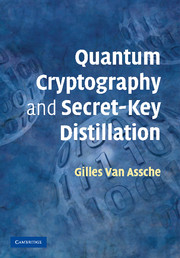Book contents
- Frontmatter
- Contents
- Foreword
- Preface
- Acknowledgments
- 1 Introduction
- 2 Classical cryptography
- 3 Information theory
- 4 Quantum information theory
- 5 Cryptosystems based on quantum key distribution
- 6 General results on secret-key distillation
- 7 Privacy amplification using hash functions
- 8 Reconciliation
- 9 Non-binary reconciliation
- 10 The BB84 protocol
- 11 Protocols with continuous variables
- 12 Security analysis of quantum key distribution
- Appendix symbols and abbreviations
- Bibliography
- Index
Foreword
Published online by Cambridge University Press: 04 August 2010
- Frontmatter
- Contents
- Foreword
- Preface
- Acknowledgments
- 1 Introduction
- 2 Classical cryptography
- 3 Information theory
- 4 Quantum information theory
- 5 Cryptosystems based on quantum key distribution
- 6 General results on secret-key distillation
- 7 Privacy amplification using hash functions
- 8 Reconciliation
- 9 Non-binary reconciliation
- 10 The BB84 protocol
- 11 Protocols with continuous variables
- 12 Security analysis of quantum key distribution
- Appendix symbols and abbreviations
- Bibliography
- Index
Summary
The distribution of secret keys through quantum means has certainly become the most mature application of quantum information science. Much has been written on quantum cryptography today, two decades after its inception by Gilles Brassard and Charles Bennett, and even longer after the pioneering work of Stephen Wiesner on non-counterfeitable quantum money which is often considered as the key to quantum cryptography. Quantum key distribution has gone from a bench-top experiment to a practical reality with products beginning to appear. As such, while there remain scientific challenges, the shift from basic science to engineering is underway. The wider interest by both the scientific and engineering community has raised the need for a fresh new perspective that addresses both.
Gilles Van Assche has taken up the challenge of approaching this exciting field from a non-traditional perspective, where classical cryptography and quantum mechanics are very closely intertwined. Most available papers on quantum cryptography suffer from being focused on one of these aspects alone, being written either by physicists or computer scientists. In contrast, probably as a consequence of his twofold background in engineering and physics, Gilles Van Assche has succeeded in writing a comprehensive monograph on this topic, which follows a very original view. It also reflects the types of challenge in this field – moving from basic science to engineering. His emphasis is on the classical procedures of authentication, reconciliation and privacy amplification as much as on the quantum mechanical basic concepts. Another noticeable feature of this book is that it provides detailed material on the very recent quantum cryptographic protocols using continuous variables, to which the author has personally contributed.
- Type
- Chapter
- Information
- Quantum Cryptography and Secret-Key Distillation , pp. ix - xPublisher: Cambridge University PressPrint publication year: 2006



